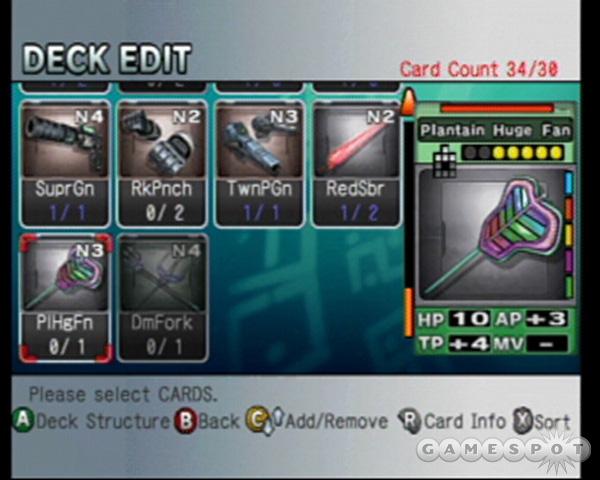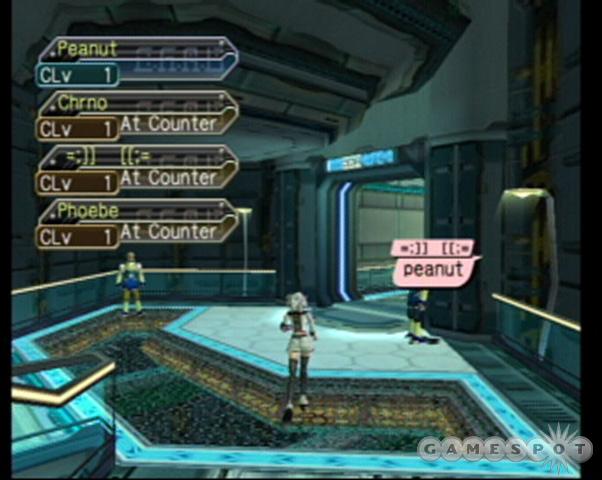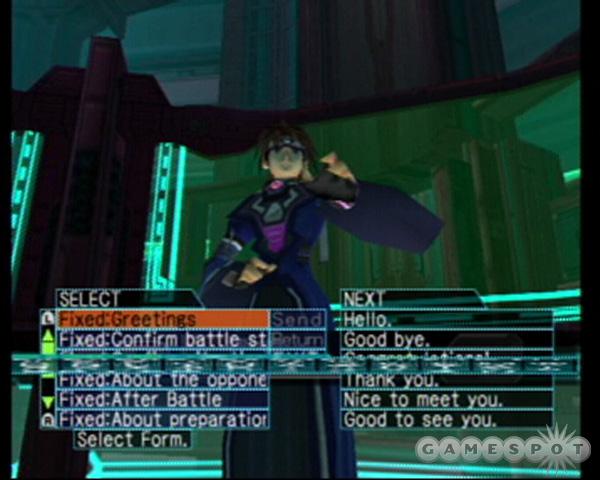When Sonic Team first launched Phantasy Star Online on the Dreamcast in early 2001 in the US, it was a landmark title. PC gamers had already been enjoying widespread online gaming for a while, but PSO was the game that shepherded online console gaming into the mainstream. The game endeared itself to thousands of players across the globe with its accessible action RPG gameplay, its extensive item system, and the community that grew from it. A sequel came out later that same year, and both episodes of PSO have made their way to the GameCube and Xbox, but it's been years since we've seen an original title bearing the Phantasy Star Online name. Enter Phantasy Star Online Episode III: C.A.R.D. Revolution, which claims the mantle as the next successor in Sonic Team's online RPG series but eschews the fast-paced action RPG mechanics that PSO has been known for in favor of a collectible card game/turn-based strategy hybrid system. It's a marked departure for the series--one that will certainly sour many fans who have enjoyed past PSO games--but different does not necessarily equate to bad.

The setup for PSO III is pretty superfluous, but for those who care, the game takes place several decades after the events in PSO I & II. The Pioneer 2 is still hovering over the largely untouched planet of Ragol, though the main problem these days is not the infestation of monsters on the planet's surface but rather the dissident group of people who have become disenfranchised from the principality that controls Pioneer 2, known as the Arkz, and who look to wrestle control away from those currently in power. After getting this quick bit of preface, you can then choose whether you want to fight for the Heroes or the Arkz, which will affect exactly what you'll be able to do in combat.
Whether you start the game in its online or offline mode, the first step in PSO III is character creation. You're presented with a list of 12 different character types, and upon selecting one, you'll be able to make some slight modifications to your character's appearance. Much like which faction you choose to align yourself with, the character type you choose will affect which cards you'll be able to use in the game. From here, the paths of the online and offline modes diverge a bit. The offline mode is pretty simple and basically just consists of battling against a series of AI-controlled opponents, under some sort of story pretense. The offline mode, however, can be incredibly useful for novice players still learning the ropes, since it's significantly easier to jump into a game in the offline mode than in the online mode, and the difficulty of the opponents you'll face ramps up at a much more manageable speed. But, if you want the real PSO III experience, you'll have to take it online.
Considering how wildly divergent the core gameplay in PSO III is from past PSO games, the game seems almost more like a spin-off than a true sequel. Though the overlying structure seems the same, the dungeon-crawling gameplay has been gutted entirely--make no mistake, the only time that you'll be controlling your character's actions in real time is on the ship in between missions. Instead, all combat is now turn-based and takes place on a grid field. Rather than purchasing or finding gear like weapons, mags, armor, or special power-ups, you'll use cards--which represent all the items in PSO III--to equip your character.

You start off the game with a default deck, but as is the convention for card battling games, you'll receive new cards that you can integrate into your deck. You can set up a multitude of different deck configurations at once, which, considering the wide variety of card types that are available, can alter your strategies dramatically. Deck building in PSO III can be a bit of an art form, especially since the game requires you to have exactly 30 cards in any of your playing decks--no more, no less. You'll regularly play a four-player game, which introduces the rather unique concept of team-based card battling. The default condition for winning a two-versus-two match is that only one player has to lose all of his hit points for the other team to win, which encourages you to actually cooperate, since the death of your teammate will mean your defeat as well.
The combat in PSO III is broken down into five distinct phases. First you use a pair of "dice" to determine the number of points you'll have that turn to perform offensive and defensive actions. Next is the set phase, where you'll pick any weapons or armor to equip, monsters to summon, or special performance-enhancing cards from the five cards in your hand. Once set, you can change your character's position on the grid during the move phase, which sets you up to attack your opponents during the action phase. Finally, there is the draw phase, where you can discard any cards from your hand that you don't want, after which you'll be on the receiving end of your opponent's turn. This may sound pretty complex, and in fact, this is an incredibly simplified explanation of the action in PSO III. Combining the actual physical space of a turn-based strategy game with the purely luck-and-statistics-driven mechanics of a card battling game makes the gameplay experience in PSO III pretty unique. Though players who have already cut their teeth on other collectible card games will likely get the most out of the game, there's a chance that fans of turn-based strategy games will find something to like about PSO III as well.
When it comes to communicating with the other players, there is no substitute for having an actual keyboard. Unfortunately, such a controller has never been released for the GameCube in the US, which will force those who want to do a lot of in-game chatting to import one, as it's nigh impossible to have a normal-paced conversation using the game's soft keyboard. The game does, however, have a preset catalog of useful phrases, which also has room for you to program in your own phrases. There's also a bizarre symbol-based chat system, which is good for hailing players with whom you might not share a common language, but it's difficult to do anything much more complex with it.

Arguably, part of the reason PSO caught on in such a massive way when it first launched on the Dreamcast was that, unlike with PC-based online RPGs like EverQuest, there was no additional cost involved in playing online. It wasn't long before the back-end costs of maintaining the PSO servers forced Sega to introduce a monthly service fee, which definitely culled many of the less-committed players. Similarly, if you want to take PSO III online, you're going to need to purchase a "hunter's license," which currently runs at $8.95 a month. This may seem a little steep to some for access to what amounts to an online collectible card game, though this price point is made easier to digest by the fact that a hunter's license purchased for PSO III will also work with the GameCube version of PSO I & II, and visa versa.
One of the more striking aspects of any Phantasy Star Online game--or, really, just about any Sonic Team-developed game--is the game's distinct visual style. The game enthusiastically incorporates anime, sci-fi, and high-fantasy aesthetics to create a bright, almost whimsical look that is definitely more than the sum of its parts. The places you'll go, both in orbit over Ragol and on the planet's surface, tend to range from lushly stylized, slightly alien wilderness to high-tech spaceships and causeways, which appear to be constructed out of materials more exotic than just glass and steel, which, despite their size and complexity, gives a sense of incredible lightness. The designs for the people who populate PSO III do a fine job of cross-pollinating the old and the new, giving you female elfin warriors who pack massive energy weapons, androids that look like French maids, and futuristic court jesters, and the creatures you summon and fight while on Ragol maintain this aesthetic.
But for all the care that has gone into specifically defining the visual design ethic of PSO, Sonic Team has neglected to make any really serious upgrades to the game's engine since it first debuted on the Dreamcast, making the game look lamentably antiquated. The game is pretty spartan as far as polygons go, both on the characters and in the environments, and the textures, while at least colorful, tend to lack detail. There's not much to speak of in terms of special effects either, as the game sports consistently flat lighting, and the shadows cast by characters and creatures alike look horribly pixelated. There are other minor annoyances--like the way the grid squares that make up the playfield noticeably float well above the actual floor--that make the visuals' technical shortcomings that much harder to ignore. The game does have progressive scan support, which, considering what you'll be looking at in high-res, is little consolation.

Concurrently, the sound design consists almost entirely of exaggerated anime sound effects, like laser blasts and that awesome fluid-sounding sword-slash effect, paired with music from past PSO games. When you're in the game's online lobby, you'll find a jukebox, and for a few mesetas, you can hear tunes from other classic Sega games as you wait for your party members to arrive or a tournament to begin. It may not be original, but all of it fits the game's tone, and the inclusion of Pro Logic II support allows it to shine just a little bit more, making it a lot tougher to fault. The only serious misstep in the game's sound design is in the voice that announces the changing of phases during combat--the guy just sounds kind of bored.
PSO III is a bit of a conundrum. For as heavily reminiscent of previous PSO games as it is, in terms of presentation and the overall structure, the new gameplay system turns it into an almost entirely new experience. Whether or not you enjoyed previous PSO games seems pretty irrelevant in deciding if PSO III is right for you. Rather, the deciding factor should be whether or not you appreciate the Phantasy Star Online aesthetic and would be interested in playing a card battling game alongside and against other players in that universe. If so, then PSO will have plenty to offer you.